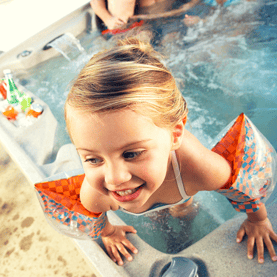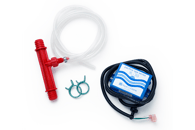The Price Conscious Shopper's Guide to Low Cost Hot Tubs in 3 Easy Parts
A short guide containing everything you need to know to purchase, install, and maintain a hot tub on a budget.
Part 1: Picking & Purchasing a Hot Tub
Think you have to drop $10,000 to get a decent hot tub? Think again! There are many affordable, and high quality, hot tubs on the market today. Just because you’re buying value doesn’t mean you have to sacrifice on quality either. If you do your homework and select a reputable brand, you can find a great hot tub for somewhere between $3,000 and $4,500. If you don’t do your homework, you could end up owning a money pit that might perform well for the first year, only to sit unused, collecting stagnant water in your backyard while you wait to get it fixed…most likely out of warranty.
We won’t let that happen to you. We’ve created a guide to make sure you’re doing the right homework to find the best, most reliable spa for your budget.

Purchasing an affordable hot tub
The first thing to consider when looking at low cost options is the manufacturer.
How long have they been in business? Are they accredited? What are current customers saying about their purchase and experience with the company? What’s their Customer Support reputation? If you need help in a few years, will they still be there?
The hot tub industry has large, international players like Watkins Wellness, as well as many smaller, local, up-and-coming or niche manufacturers. Do your research and make sure whatever brand you choose is backed by a manufacturer with a legacy in the industry and a reputation that gives you confidence they’ll be around to support you for the life of your spa, which could and should be 10-15 years (maybe more!).
Next, explore your options
There are many value hot tubs available on the market today. A quick Google search will turn up anything from $400 inflatable spas to more traditional hot tubs with heaters and jets.
Let’s break it down – if you need something that you can put up for a few days (like for a party, renting a house somewhere, or taking to the desert) and then take down, an inflatable might be right for you. But there are some drawbacks to this quick solution to your hot tub needs.
Factors to Consider When Looking at an Inflatable Spa
The heater is usually on the outside of the spa. Think of it like a kid’s bounce house. It’s easy to set up, sure. But with the external heater, it’s also easy to damage and not too easy to look at. With inflatable hot tubs, you will most likely be sitting on the ground as they do not come with any seating options. There’s very little, if any, insulation, which means the water will cool down faster and cost more to heat up when you’re ready to soak again. You may get a whirlpool-style jet included, if you’re lucky, which will move the water around, but you won’t get the variety of jets or have the option to change direction or flow of those jets in an inflatable tub.
If you are looking for more out of your hot tubbing experience than what an inflatable hot tub offers but you’re not quite ready for that $10,000 price tag, you’re ready to move on to a more traditional hot tub made from rotationally molded plastic.
Rotationally Molded Spas
.png?width=252&name=Screenshot%20(13).png)
What is rotationally molded plastic, you ask? Great question! Here's a quick breakdown of "Rotomolding."
It refers to the manufacturing process whereby plastic resin is melted and spread inside a hot tub mold, producing a durable yet lightweight, unibody shell. With less material and labor costs to manufacture, rotomolded spas are more cost effective yet still high quality and feature rich.
.png?width=269&name=Screenshot%20(14).png)
Speaking of features, you can, and should, expect to see the creature comforts synonymous with hot tubbing like multiple jets, digital control panels, waterfall features, and LED lights, to name a few. And, maybe even a few value-adds you never dreamed of, like a built-in cooler and accessory tray, sure to make any soak a true relaxation session. Regardless of the feature set, rotomolded hot tubs usually cost between $3,000-$5,500 as compared with their acrylic counterparts, which range between $7,000 and $15,000.
Like all products, rotomolded hot tubs range in quality. This goes back to doing your homework on the manufacturer to determine if they’re reputable, reliable, and using high-quality components that have a low service record and are easy to maintain.
Part 2: Installation
Complicated installations may have many hot tub skeptics shaking their heads… But luckily, heavy tubs and custom wiring are not your only option. (See part 1 to learn about rotationally molded spas.)
Custom wiring or Plug-N-Play?
Electrical configuration of the spa will affect cost, both at the time of purchase and beyond with electric bills.
A 110v Plug-N-Play model will not require any additional wiring and can be plugged into any standard outlet. That’s the beauty of Plug-N-Play spas. You simply fill them up with a garden hose, plug them into an outlet, and start soaking.
A 230v model, on the other hand, will have to be hard wired to a 230v hookup, which requires a sub panel and an electrician to set up. This could cost anywhere from several hundred to $1,000 dollars and should be factored into your budget when shopping for a spa. If you’re curious as to the difference between 110v and 220v spas, click here to read more.
The good news is that there are many quality spas that simply plug in, offering an affordable solution.
Consider any additional installation costs, like the flat, level surface on which you’ll place your spa. Don’t have one? You can always pour a concrete pad or install pavers to create a foundation for your dedicated hot tub oasis. If you are planning to purchase a smaller spa, you might consider putting it on a deck or patio. Just be certain that wherever you put your spa, it sits on a solid, 4” thick foundation that can support the weight of the spa, water, and people. See our FAQs here before purchasing for some extra tips and tricks!
Part 3: Maintenance
Energy Costs
The number one, ongoing maintenance cost of hot tub ownership is the monthly electric bill. Lots of manufacturers make claims about their energy efficiency and energy consumption. Keep an eye out for any certification from a reputable government agency, validating the claims of energy efficiency.
The best way to ensure energy efficiency is insulation. The more insulation, the more energy efficient the spa will be. Some manufacturers fully insulate their spa with spray-in foam that expands to cover all open areas. Other spas use partial insulation, leaving gaps under the spa for heat to escape, requiring more energy to heat up the water and maintain that hotter temperature. When searching for an energy efficient spa, look for terms like "full-foam insulation" and "multi-density foam insulation."
Hot Tub Covers
In addition to insulation, the hot tub cover will have a big impact on heat retention. Always check that the spa you are considering has a thermal, insulated cover that is intended to last at least 3-5 years. You will know when it's time to replace your cover if it becomes waterlogged, cracked, or broken. The cost of a replacement cover will greatly depend on the size of your spa, but typically range from $200-$400 each.
When you pair a thermal, locking cover with full foam insulation, you are getting a truly energy efficient spa that will keep your electric bills in check. Anything less, and you could be signing on for more than you imagined.
Water Treatment
You’re going to want crystal clear water for each soak, right? Well, that’s going to require a little bit of time and money on your part. But you knew that was coming.

Your spa will come with its first filter already installed. You’ll be able to get some extra miles out of your filter by rinsing it off every other week with a garden hose. Make sure to get between the folds! Want an insider tip? Run your filter through your dishwasher for a more thorough clean. Just be sure to wash only; no soap or drying cycle allowed! You will need to replace a filter, even a routinely cleaned one, every 6 months to a year, depending on how often you soak.
Of course, in addition to your filter, you’ll need to balance your water as well. Go to your local hot tub store to buy the necessary supplies like pH balance, bromine, and chlorine. Check out this quick video we made to see just how easy it is to keep that water clean. Just a little regular maintenance will go a long way to keeping your water clean and preventing unexpected hot tub ownership expenses.

If you want to extend the life of your water with the fewest chemicals required, you might opt for a spa with an ozone water care system. You may also purchase an ozone kit if the spa you like does not come with one. It’s a small accessory that’s easy to install yourself or with the help of your local dealer. This feature helps rid your spa water from organic contaminants, such as soaps, lotions, sunscreens, etc. that can cloud the water.
The memories and experiences that come with hot tub ownership are priceless. When searching for the perfect hot tub for your lifestyle and budget, consider a Freeflow spa. With unmatched customer support, backed by 40+ years of hot tub expertise, innovative designs, and tangible price points, we are proud to offer hot tubs to fit any needs.
The Mini has room for two, and fits just about anywhere in a compact footprint with a roomy interior! Those looking to entertain friends and family love our 7-person Monterey spa with deep, jetted seats, a waterfall feature, and built-in cooler. Or, if you're looking for something in-between, we have spa models for that, too!
We are excited for you to enjoy the many benefits of hot tubbing, to get started fill out the form below and your local retailer will be in-touch. Happy soaking!
{formbuilder:64326}
